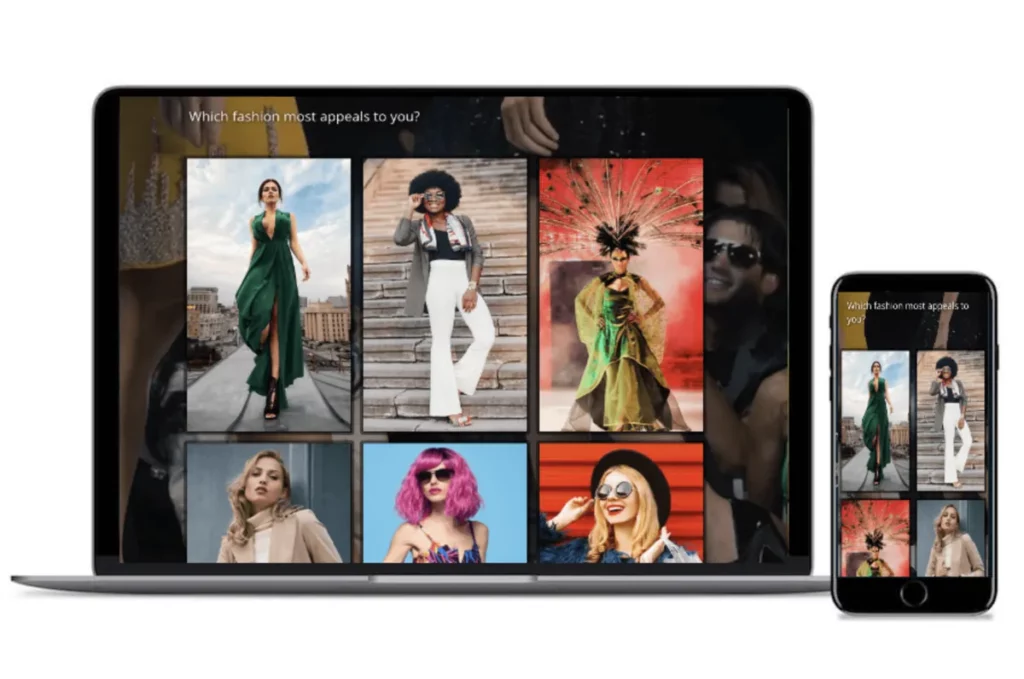Surveys are a great way to gather research and information from the general public or a specific target audience. The results can be used to validate or debunk theories, inform business decisions, and improve products and/or the customer or employee experience.
Create your fun survey, poll, or questionnaire now!
8 Ways To Make a Fun Survey
So how do you make a fun online survey, especially if the topic is pretty dry? There are a number of ways to engage people with surveys. Even if you don’t have any particularly “fun questions to ask,” there are still a number of ways to create a survey that will get responses. Here’s our top eight ways to make a fun survey online.1. Use Visual Appeal
Studies show that humans are 90% visual beings, processing visuals 60,000 times faster than text. So, while you want respondents to read your questions, they’re more likely to do so if the survey or form has eye appeal! This could mean using a template with an attractive or fun background, including images that sync up with the questions, or choosing a nice-looking font. Learn more about photo surveys and polls with pictures.2. Be Funny
This may seem like a no-brainer: Make a survey fun by being funny! Of course, certain professional surveys, and surveys surrounding certain topics, should not tickle the funny bone. However, when humor fits within the context of your survey, put it to use to create engaging survey questions! This could mean wording your questions in a humorous way, creating fun survey questions, including funny GIFs, and more.3. Be Conversational
While personalization may not be “fun,” per se, it can certainly make the survey-taking experience much more enjoyable. So, if you know who your audience is, direct the messaging to them. It also helps to be sincere, building a respectful, loyal relationship with respondents (especially if they’re already your customers). So while your survey can be fun, colorful, and interesting, it should also include an “ask” at the start in which you sincerely ask respondents to take the time to complete the survey and let them know how much it will help you out if they do so (and how it may benefit them, if that’s the case).4. Use Multiple Channels
The majority of online surveys arrive in a respondent’s email inbox. But what if they ignore it, or aren’t too keen on email? Make your survey more fun and accessible by offering the ability to take it on multiple channels. One thing that can really pique the interest of potential respondents is if they “run into you” all over the internet! Consider posting your survey to relevant marketing pages, sending it out via social media channels, or delivering it through SMS texting. By the second or third time someone sees your survey, they’re likely to be curious and give it their time in order to learn more.5. Offer Incentives
Most people responding to surveys like to be helpful, are invested in the topic, or want their voice to be heard. Others need an incentive – some sort of prize or reward provided upon completion of the survey. Often, the incentive is financial; it could be a gift card or a discount on a particular product. Let’s face it; the knowledge that you’ll get a $10 Starbucks gift card just for answering a few questions makes for a fun survey! Read more about the pros and cons of survey incentives.6. Show Results
Studies show that about 10% of our thoughts involve comparisons of some kind. Social comparison theory, developed in 1954 by psychologist Leon Festinger, states that people determine their own social and personal worth based on how they stack up against others. So, be sure to share the results of the survey after a respondent has completed it so they can see how their answers compare to other survey-takers. Just be sure to keep the results anonymous to protect the privacy of all respondents.7. Offer Sharing
Along with wanting to see the results of other respondents, people like to share with others too. So, unless you’re targeting a very specific audience and don’t want random responses from unvetted people, you should give respondents the option to share the results of their survey on social media (or just a link to your survey). Bonus: This can garner you even more respondents, at no cost to you!8. Keep It Short
Unless a respondent is truly invested in a survey or its results, they’re unlikely to commit to a lengthy survey, especially without an incentive. However, most people – without any sort of incentive – will commit to a short survey if it will take them five minutes or less (some may even welcome the break from normal activities). So, be sure to whittle your survey down only the most urgent questions, and avoid asking repetitive or redundant questions. You want to show respondents that you respect their time. You might also use mainly multiple-choice questions or a Likert scale to make questions easier to answer. Read more about short surveys in our blog on microsurveys.Conclusion
If you want a survey that gets results, it helps to make a fun online survey. While not all surveys should aim for laughs, especially if they’re focused on serious subjects, fun survey questions, design, placement, and more can help if the topic is right for it. Are you ready to create your next fun survey? Try SurveyLegend for free! We have dozens of fun-looking, pre-designed templates that are responsive, secure, and sure to get attention.Create your fun survey, poll, or questionnaire now!
Frequently Asked Questions (FAQs)
Responsive design enables surveys to display on any device or screen by adjusting elements on the page, automatically rearranging, shrinking, or expanding to fit the format.
This theory was developed in 1954 by psychologist Leon Festinger. It states that people determine their own social and personal worth based on how they compare to others.
You can make surveys more fun by using colors, images, and appealing fonts. Other ways to make a survey fun include offering incentives, sharing abilities, and results.




